Since blog-posting brevity is not usually one of my strong suits, I figured it was time I tackle a subject that has to be short. The topic itself is small. Chances are, I’m making a mountain out of a molehill. But it nonetheless caught my attention as a potential harbinger of problems down the road.
The newly completed Mozzo on Virginia Avenue in the Holy Rosary neighborhood has started leasing its residential units. This building and its counterpart, Hinge (just a block further to the southeast) have ushered what hopefully will be a wave of multifamily housing construction in a part of town that is steadily revitalizing. The building fills its parcel elegantly, with a street wall befitting a neighborhood filled with structures that predate the automobile.
The Mozzo doesn’t have a great deal of retail (only 1700 square feet on its southeasternmost corner), but retail absorption rates in central Indy suggest that the area currently struggles with an oversupply—like just about everywhere else in this country. At any rate, the street-level apartment units could adapt to a retail reconfiguration without requiring a great deal of new construction, should the demand rise.
So the real curiosity is that pocket of retail on the one side of the building, at the intersection of Virginia Avenue and Merrill Street.
The promotional signs in the window indicate that the space could feature outdoor seating. Are they sure about that?
On one side it fronts a sidewalk of conventional width for this neighborhood: between 3.5 and 4 feet (impeded, per the course for Indianapolis, by utility poles).
On the Virginia Avenue side it fronts a generous, double-barreled sidewalk in the Cultural Trail, with one avenue devoted to bicycle traffic and the other (the one closest to the building) for pedestrians.
Since the Cultural Trail’s primary reason for being is as an active multi-use trail, where’s that outdoor seating going to go?
The only place I can conceive of is the small wedge of pavement to either side of this front door, but I’d be surprised if this space has room for more than two deuces.
What appears to be misinformation embedded in the Mozzo’s promotion of its retail space will probably have little impact on the building’s ability to secure a tenant in the long run. Potentially more problematic is what it suggests about attitudes toward the use of Cultural Trail. This generously sized easement clearly intends to encourage more people to traverse the length of Virginia Avenue by foot or by bike.
Not surprisingly, another huge way to galvanize foot traffic is to saturate the streetscape with activities that promote lateral interest. Storefronts and cafés may seem like clichés in an era of gentrification crusaders, but they generally achieve this coveted goal. Will the retail that many hope will eventually comprise the full length of Virginia Street eventually necessitate a reconfiguration of the Cultural Trail to encompass more passive outdoor uses, such as outdoor café seating? Maybe that first tenant who signs the lease at the Mozzo will encourage some real dialogue.
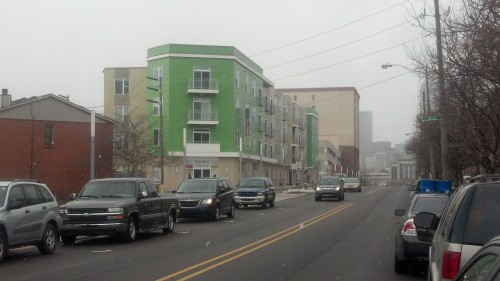
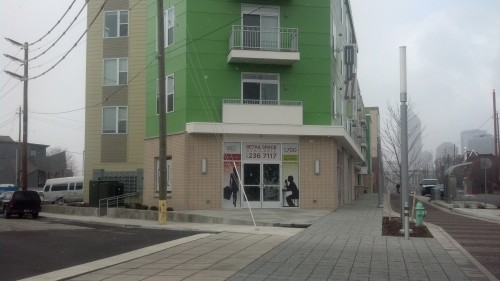
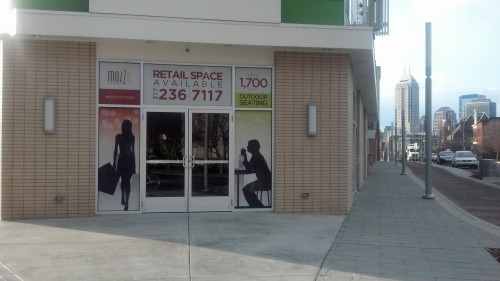
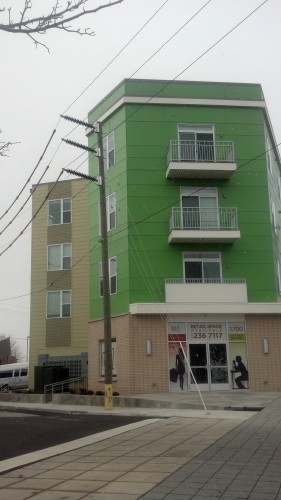
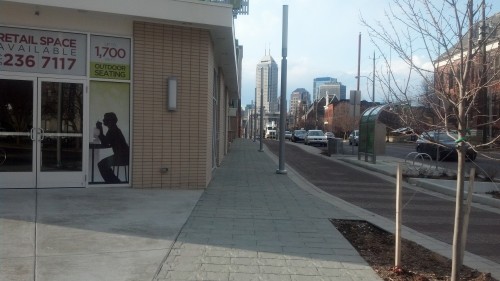
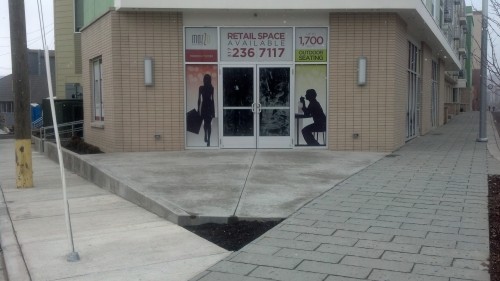
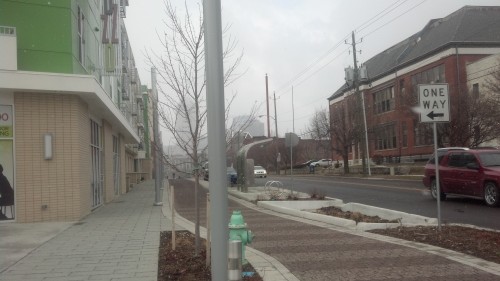
Often, marketing doesn’t line up with reality- http://groundlevelmw.blogspot.com/2013/02/jeffrey-r-anderson-real-estates-stay.html. It does look like there is some room within the triangular area for seating and that entrance may be able to be fenced off entirely for seating with access provided from another doorway.
Nice link to the Rookwood piece. I’ve been to that shopping area a few times, and it’s definitely a typical suburban car-heavy “strip mall”. It’s definitely not the destination that JR can build upon. That’s what OTR and The Banks are for.
Perhaps it’s just a deceptive photo but the pedestrian side of the Cultural Trail looks narrower than usual adjacent to the Mozzo building, especially with that lightpost intruding into it. I can’t possibly imagine how any outdoor seating or additional obstructions could be accommodated there.
The patio area at Mozzo was designed to seat 24 with six round fourtops. With bistro-sized tops, you could possibly seat a few more people. The size of the retail space and the outdoor area associated with the retail space was determined by a collaboration between Milhaus and the neighboring residences of Merrill Street. It is appropriately sized for the desired use which would be a breakfast/lunch cafe use. When a tenant occupies the space, their front door will be on the trailside and the doors from the wedge will be for their cafe patio.
Thank you for the responses, especially for that clarification, Craig. While I can’t conceptualize how this would work, I certainly believe you. If you have a rendering or site plan you would be able to include, I could reintegrate it to an updated version of this article.
It continues to amaze me how new construction like this can’t manage to put signposts and lightpoles out of the middle of pedestrian travel.
Just center the damn things on the centerline of the concrete dividing line! Is that too hard? Oops, there goes my OCD-ness again 😉
Hey John,
I’m assuming you mean the lamps for the Cultural Trail? I would prefer they were closer to the pedestrian side (as they are) rather than the bike side.
If you are referring to the utility pole, that was already like that for years, unfortunately. Very annoying.
I lived across from the Mozzo site until last March (so just before the BMV was demolished) and was a party to the planning phase. In dealing with Milhaus, I was disappointed at the lack of engagement with the surrounding community.
All 11 residences on Merrill St to the south of this site had some major concerns about the safety with respect to how they were planning the site. These included major traffic increases on Merrill (a very small one way), use of the unimproved alley parallel to Virginia for perpendicular garages across from a residence, and the parking lot sloping down to an area that regularly flooded before the parking lot.
Milhaus repeatedly told us “We’ve addressed your concerns.” By addressed, they meant that they had made, in my opinion, very aggressive assumptions regarding traffic flow and speed, vehicle turning radius, and the capacity of the very small bioswales.
They made some aggressive assumptions in non-safety related areas too. One being that many residents would not have vehicles (I like this assumption, but doubt it will be true somewhere as car dependent as Indy). The other was that the little area shown in the above pictures was not only going to have quite a bit of patio seating, but was also going to have a much larger triangular-shaped planter at the tip.
Overall, I was very disappointed at the lack of engagement from Milhaus and I’m not surprised that things are turning out much more in line with my assumptions than theirs.
I like a crowded feel. We need more of that in Indy. I think it’ll be great to have four or five (or six) little tables out there in that triangle area. I wouldn’t even mind having three or four small two-tops right next to the building. People will be walking by. There is room to pass. Its not that crowded – and if it gets a little crowded – its a good thing, in my opinion. I find it amazing how many people they can squeeze into some of those little sidewalk cafe areas in some of the crowded parts of the near north side of Chicago. I’m not worried about this at all. I hope it gets so busy that the other street front areas of this building get turned into commercial spaces.
Any creative tenant should be able to find seating that will fit that space perfectly. Imagine a small coffee/dessert shop with small, comfy pouffy seats or a sandwich cafe with raised, bar-style seats. Not all outdoor seating options should be confined to round tables with 4 chairs. It’s true that Indy is extremely car-dependent but turning the wheel to being bike-related takes the creative people that are living in the area to take a risk in opening up the perfect shop here that will cater something to the community. I’m talking hipsters with jewelry making skills, crafty beer shop, or a nice little cafe. Let’s see what the enterprising commercial community can create!
Thanks again for all your responses. While I encourage as much flexibility as possible, I’m still not sure I see how the space is big enough even to fit TWO of the conventional round-table 4-top. But a person involved in the project has spoken on this, and I’m sure he is far more clued-in to the spatial considerations than I am, so maybe it will work. I’m perfectly fine with anything going here, and it may end up working best if it hosts casual cafe seating without direct table service.
Sometimes, though, the physical form of the building precludes what would be the most desirable use. The best example I can think of this mismatch is the canal-side space on the Cosmopolitan building. It hasn’t had much luck securing a tenant, as most people know, and while this could be due to inadequate foot traffic along the persistently mediocre Canal, it may also be attributable to the storefront itself. It’s tiny. Room for interior seating is meager, so the tenant will always depend heavily on the space for outdoor seating. But, in the winter, Indiana temperatures discourage outdoor seating, meaning that a restaurant owner (like the unsuccessful Left Bank Cafe) will lose 70% of the available seating during the colder half of the year.